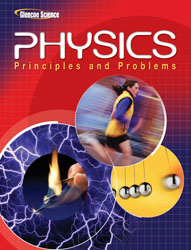1 A) weaker than the electromagnetic force, but has more range B) stronger than the electromagnetic force, but has more range C) stronger than the electromagnetic force, but has less range D) weaker than the electromagnetic force, but has less range 2 The phosphorus isotope has a mass defect of '-0.282253 u. What is the binding energy?
<a onClick="window.open('/olcweb/cgi/pluginpop.cgi?it=jpg::::/sites/dl/free/0078807220/617938/oi.JPG','popWin', 'width=NaN,height=NaN,resizable,scrollbars');" href="#"><img valign="absmiddle" height="16" width="16" border="0" src="/olcweb/styles/shared/linkicons/image.gif"> (2.0K)</a> A) ?-26.292 MeV B) ?-212.62 MeV C) ?-262.92 MeV D) ?-765.92 MeV 3 -4 u? (1 u = 931.49 MeV.)A) 8.04×102 MeV B) ?8.04×10-1 MeV C) 9.26×102 MeV D) 9.26 × 107 MeV 4 A) a positron B) a beta particle C) an electron D) a proton 5 Calculate the mass defect of (4.02602 u). The mass of a proton is 1.007825 u and the mass of a neutron is 1.008665 u.
<a onClick="window.open('/olcweb/cgi/pluginpop.cgi?it=jpg::::/sites/dl/free/0078807220/617938/oj.JPG','popWin', 'width=NaN,height=NaN,resizable,scrollbars');" href="#"><img valign="absmiddle" height="16" width="16" border="0" src="/olcweb/styles/shared/linkicons/image.gif"> (2.0K)</a> A) -0.00696 u B) -0.032058 u C) -0.029538 u D) -0.028398 u 6 A) protons B) neutrons C) particles D) electrons 7 A) 8.35×10-27 kg B) 6.68×10-27 kg C) 1.67×10-27 kg D) 3.34×10-27 kg 8 A) It disappears completely. B) It becomes binding energy. C) It becomes binding mass. D) It is destroyed. 9 A) There are partial neutrons. B) There are isotopes. C) The mass of the electrons must be considered. D) There are partial protons. 10 A) E = m /c B) E = mc 2 C) m = Ec 2 D) E = mc 11 A) neutral particle beams used in the lab B) the existence of electrons outside the nucleus C) atomic radiation D) the mass of the nucleus being larger than the mass of the protons 12 A) the difference between the sum of the individual masses of the nucleons and the mass of the nucleus B) the difference in mass between protons and neutrons C) the difference in mass between protons and electrons D) the difference in masses of different isotopes 13 A) electrical force B) weak nuclear force C) gravity D) strong nuclear force 14 m = 1.673×10-27 kg; 1 eV = 1.60×10-19 J)?A) 241 MeV B) 2.41 MeV C) 941 MeV D) 9.41 MeV 15 A) the number of particles B) the number of electrons C) the number of neutrons D) the number of protons 16 A) polonium 194 B) hydrogen 3 C) cobalt 60 D) polonium 210 17 A) They are easily made. B) They have no charge. C) They are very heavy. D) They move very fast. 18 A) fission B) fusion C) production D) annihilation 19 A) 0.125 B) 0.0009 C) 0.05 D) 0.1 20 A) by condensation B) by moving through a paddle wheel C) by moving water D) by turbines 21 A) speeds up slow neutrons B) slows fast neutrons C) absorbs neutrons D) increases the amount of fission 22 A) increases by two B) decreases by two C) decreases, but very slightly D) remains the same 23 A) 22.8 years B) 8.55 years C) 5.70 years D) 2.85 years 24 A) to absorb isotopes B) to absorb neutrons C) to absorb protons D) to absorb electrons 25 A) gamma, beta, alpha B) alpha, gamma, beta C) alpha, beta, gamma D) beta, gamma, alpha 26 Why is the following reaction desirable as a power source?
<a onClick="window.open('/olcweb/cgi/pluginpop.cgi?it=jpg::::/sites/dl/free/0078807220/617938/ol.JPG','popWin', 'width=NaN,height=NaN,resizable,scrollbars');" href="#"><img valign="absmiddle" height="16" width="16" border="0" src="/olcweb/styles/shared/linkicons/image.gif"> (5.0K)</a> A) this cannot reach a chain reaction B) this isn't nuclear C) there's no radioactive waste D) there are no neutrons produced 27 A) two smaller nuclei combine to form a larger one B) nuclei decay C) a large nucleus is split D) radioactive particles are emitted from the nucleus 28 When is bombarded by and results in what else is emitted?
<a onClick="window.open('/olcweb/cgi/pluginpop.cgi?it=jpg::::/sites/dl/free/0078807220/617938/ok.JPG','popWin', 'width=NaN,height=NaN,resizable,scrollbars');" href="#"><img valign="absmiddle" height="16" width="16" border="0" src="/olcweb/styles/shared/linkicons/image.gif"> (1.0K)</a> A) a positron B) an electron C) a proton D) a neutron 29 A) chain B) critical mass C) thermonuclear D) fission 30 A) PET scans B) radioactive tracing C) X rays D) ultrasound 31 A) nuclear B) beta C) gamma D) alpha 32 A) Neutrons released from nuclear fission strike other nuclei and cause them to undergo fission. B) Electrons released from nuclei strike other nuclei and cause them to break apart. C) Neutrons stop reactions in the material. D) Protons released from nuclei strike other nuclei and cause them to break apart. 33 According to the figure below, what percentage of the original sample of a radioactive substance would be left after 4 half-lives?
<a onClick="window.open('/olcweb/cgi/pluginpop.cgi?it=jpg::::/sites/dl/free/0078807220/617938/om.JPG','popWin', 'width=NaN,height=NaN,resizable,scrollbars');" href="#"><img valign="absmiddle" height="16" width="16" border="0" src="/olcweb/styles/shared/linkicons/image.gif"> (11.0K)</a> A) 0.0625 B) 0.25 C) 0.5 D) 0.125 34 A) The entire mass of the atoms B) The energy equivalence of the difference in mass of the reactants and the products C) The mass of the neutrons in isotopes D) The difference in mass between the protons and neutrons 35 A) a meson B) a neutron C) a proton D) an electron 36 A) momentum and energy B) sound and momentum C) mass and charge D) charge and energy 37 A) annihilation B) production C) shattering of the particles into more particles D) more protons 38 A) They cannot move fast. B) They are too small. C) They are too heavy. D) They have no charge. 39 A) a particle made of a quark and an antiquark B) the largest elementary particle C) a boson D) a lepton 40 A) electric fields B) wind C) gasoline D) fire 41 A) atoms ionizing gas B) a charged particle or a gamma ray ionizing gas C) X rays D) neutrons ionizing gas 42 A) quarks, leptons, and gluons B) leptons, bosons, and electrons C) quarks, leptons, and force carriers D) force carriers, gluons, and quarks














